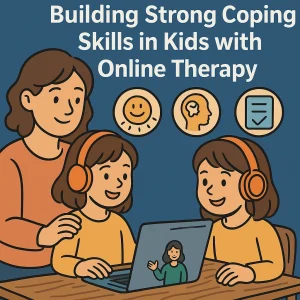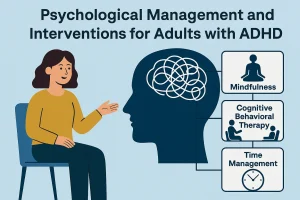Teaching Kids Emotional Awareness: 8 Simple Methods
Last Updated: September 9, 2024
Emotional awareness is crucial for children’s development. It goes beyond recognizing happiness or sadness—it involves understanding and expressing a spectrum of emotions effectively. This skill is foundational, enabling kids to better understand themselves and interact constructively with others, fostering strong relationships and effective navigation through life’s challenges. Teaching kids to identify and articulate their feelings isn’t just about expression; it sets the groundwork for their emotional resilience and social competence, reducing frustrations, preventing behavioral issues, and boosting self-esteem.
8 Simple Ways to Teach Kids
1. Start with Basic Emotions
When teaching kids to name their feelings, it’s best to start simple. Begin with the basic emotions: happy, sad, angry, and scared. These are feelings that children frequently experience, making them the perfect starting point for emotional learning. By understanding these core emotions, kids can build a foundation that will help them identify more complex feelings as they grow.
Tips:
Use simple words and relatable scenarios to introduce these emotions. For example, when your child is laughing, you can say, “You look so happy right now!” Similarly, when they’re upset because they dropped their ice cream, you might say, “It seems like you’re feeling sad.” Pairing these words with facial expressions—like smiling for happy or frowning for sad—helps kids connect the words to the feelings. You can also use everyday situations, like talking about how a favorite toy makes them happy or how missing a fun event might make them feel sad or disappointed. The goal is to make emotions relatable and easy to understand in their daily lives.
2. Use Picture Books and Stories
Books are a wonderful tool for teaching kids about emotions. Picture books that focus on feelings can open up conversations about emotions in a way that’s engaging and accessible for children. Stories often feature characters going through a range of emotions, which can help your child see how feelings are a natural part of life and how they can be expressed.
Tips:
Choose books that specifically address emotions and read them together with your child. While reading, ask open-ended questions like, “How do you think the character feels?” or “What do you think made them feel that way?” This not only helps kids recognize different emotions but also encourages them to think about why those emotions occur. Use the illustrations as visual aids—pointing out the character’s facial expressions or body language can make the discussion more vivid and relatable. By making this a regular activity, you create a safe space where your child feels comfortable exploring and talking about their own emotions.
3. Play Emotion Identification Games
Learning about emotions doesn’t have to be all talk—making it fun can make all the difference. Emotion identification games are a great way to engage your child and reinforce what they’ve learned about feelings. Simple games like “Emotion Charades,” where kids act out different emotions and others guess, can make learning interactive and enjoyable. Another option is using flashcards with faces showing different emotions, encouraging kids to match the faces to the correct feelings. These games not only teach kids to identify and name their emotions but also help them understand how those feelings look in others.
Tips:
Try to incorporate these games into your daily routines or during family playtime. This keeps the learning consistent without making it feel like a chore. For example, during dinner, you might have a quick round of charades, or before bed, match a few emotion cards. The key is to make these activities a natural and fun part of their day, turning learning into a positive experience they look forward to.
4. Model Emotional Expression
Kids learn a lot by watching the adults around them, so one of the most powerful ways to teach emotional awareness is to model it yourself. Show your own emotions openly and appropriately in everyday situations. Whether you’re excited about something new, disappointed about a change in plans, or grateful for a kind gesture, expressing your feelings aloud helps your child see how emotions are a normal and manageable part of life.
Tips:
Use simple phrases like “I feel happy when we spend time together” or “I’m a bit frustrated because things didn’t go as planned.” This not only models the language they can use but also normalizes talking about feelings in a calm and constructive way. Be mindful of how you react to your own emotions, as children often mirror the emotional responses of the adults they look up to. By modeling healthy emotional expression, you provide your child with a clear and practical example of how to handle their own feelings.
5. Encourage Daily Emotion Check-ins
A great way to help kids become more comfortable with identifying and naming their emotions is to make it a part of their daily routine. Implementing daily emotion check-ins can be an effective strategy. This can be as simple as asking your child how they felt during the day at bedtime or after school. By regularly giving them space to talk about their feelings, you create a safe environment where emotions are normalized and understood.
Tips:
To make these check-ins engaging, consider using tools like emotion charts or feeling faces. These visual aids allow kids to point to or choose a face that represents how they’re feeling, making it easier for them to express themselves even when they might not have the right words. You can also keep a feelings jar where your child drops in a card describing their emotions for the day. Over time, this routine will help them become more fluent in the language of emotions, which is crucial for their emotional development and communication skills.
6. Use Art and Creative Activities
Art can be a powerful way for children to express their emotions without needing to put them into words. Drawing, painting, or crafting allows kids to explore their feelings in a safe and creative way. For some children, especially those who are shy or find it hard to talk about their emotions, art becomes a medium through which they can express themselves freely.
Tips:
Encourage your child to create art based on how they’re feeling that day. For instance, you could ask, “Can you draw what made you feel happy today?” or “Show me with colors how you’re feeling right now.” Afterward, take a moment to discuss their artwork together, asking open-ended questions about what they’ve created. This not only helps them articulate their emotions but also gives you insight into their inner world. Engaging in these creative activities regularly can help your child feel more understood and supported in expressing their feelings.
7. Teach Through Role-Playing
Role-playing is a fantastic way to help kids explore different emotions and understand how they might feel in various situations. By acting out scenarios, children can practice identifying and expressing emotions in a safe and controlled environment. This method not only helps kids recognize their own feelings but also teaches empathy as they step into the shoes of others.
Tips:
Encourage your child to switch roles during role-playing activities. For instance, if you’re acting out a scenario where someone feels left out, let your child play both the person feeling excluded and the one who can include them. This role-switching helps them see the situation from different perspectives, deepening their understanding of various emotions. Use everyday situations or challenges your child might face, such as handling a disagreement with a friend or trying something new that feels scary. By making these activities relatable, you’ll help your child connect the emotions they practice to real-life experiences.
8. Introduce Emotion Words Gradually
Expanding your child’s emotional vocabulary is an important step in teaching kids to name and express their feelings more precisely. Start with basic words like “happy,” “sad,” “angry,” and “scared,” then gradually introduce more specific terms like “frustrated,” “excited,” “disappointed,” or “nervous.” By increasing their emotional vocabulary, you give kids the tools to articulate what they’re feeling, which can reduce frustration and help them communicate more effectively.
Tips:
Use descriptive language when talking about emotions and connect new words to experiences they’ve had. For example, if your child looks hesitant on the first day of school, you might say, “You seem a bit nervous. That’s okay—it’s normal to feel that way when starting something new.” Relating the words to their personal experiences helps solidify their understanding and makes the emotions more meaningful. Make this a natural part of your conversations, and soon enough, your child will be using these new words with confidence.
Emotion Words Introduction Plan
| Emotion Words | Simple Definition | Related Situation or Example |
|---|---|---|
| Happy | Feeling joy or pleasure | Playing with friends |
| Sad | Feeling down or upset | Missing a favorite toy |
| Angry | Feeling mad or annoyed | Someone taking their toy |
| Scared | Feeling afraid or worried | Hearing a loud noise |
| Excited | Feeling thrilled or eager | Going to a birthday party |
| Frustated | Feeling upset because something is hard | When a toy doesn’t work |
| Nervous | Feeling a little scared about what might happen | First day of school |
| Proud | Feeling pleased with yourself or someone else | Finishing a difficult puzzle |
| Disappointed | Feeling let down when things don’t go as expected | Not getting a promised treat |
| Confused | Feeling unsure or mixed up about something | Learning a new game |
Conclusion
Teaching kids to name their feelings is a valuable skill that helps them understand themselves and others better. By using simple strategies like starting with basic emotions, reading picture books, playing fun games, showing your own feelings, doing daily emotion check-ins, encouraging art, role-playing, and gradually adding new emotion words, you can make learning about emotions easy and fun for your child. These activities help kids recognize their emotions and express them confidently, building a strong foundation for their emotional growth.
Remember, it’s all about consistency and patience. Every child learns at their own pace, so keep practicing these methods regularly, and don’t worry if progress seems slow at times. Encourage your child and create a supportive environment where they feel safe to express how they feel. We’d love to hear your experiences and tips—share them in the comments or pass this article along to others who might find it helpful. And if you need more support, Wellness Hub offers resources and guidance to help you on this journey. By taking these small steps, you’re helping your child develop skills that will benefit them for a lifetime.
Frequently Asked Questions:
1. Why is it important to teach kids to name their feelings?
Teaching kids to name their feelings helps them understand their emotions, improves their communication skills, and builds emotional intelligence. It allows them to express what they’re experiencing, which can reduce frustration and improve their relationships with others.
2. What are some simple ways to help children identify their emotions?
You can start by teaching basic emotions like happy, sad, angry, and scared. Use picture books, emotion identification games, daily check-ins, and creative activities like drawing to help them learn and express their feelings.
3. How can I use games to teach my child about emotions?
Emotion identification games like “Emotion Charades” or matching faces to feelings can make learning about emotions fun. These games help children recognize and name different emotions in an engaging and interactive way.
4. How can role-playing help my child understand feelings?
Role-playing allows children to act out different scenarios and explore emotions in a safe environment. By switching roles, kids can see situations from different perspectives, which helps them understand a wider range of emotions and develop empathy.
5. What are some good books to help kids learn about feelings?
Books that focus on emotions and feelings are great resources. Look for picture books with characters who experience a range of emotions, as these stories can open up discussions and help kids relate to the feelings expressed in the books.
6. How can art activities help children express their emotions?
Art activities like drawing, painting, or crafting provide kids with a creative outlet to express their feelings. You can ask them to create art based on how they feel, which can help them communicate emotions they might not be able to put into words.
7. How often should I do emotion check-ins with my child?
Daily emotion check-ins are ideal. Incorporate them into routines like bedtime or after school. Use tools like emotion charts or feeling faces to make these check-ins engaging and to help your child become comfortable with naming their emotions regularly.
8. How can I gradually introduce new emotion words to my child?
Start with basic emotion words and slowly add more specific terms like “frustrated,” “excited,” or “nervous.” Use descriptive language in everyday conversations and relate new words to situations your child has experienced to help them understand and remember these emotions.
9. How can I encourage my child to talk about their feelings?
Encourage your child to talk about their feelings by creating a safe and open environment where emotions are welcomed and not judged. Regularly ask them how they feel and listen attentively. You can also share your own feelings using simple phrases like “I feel happy when we spend time together,” which models how to express emotions verbally and encourages them to do the same.
10. What should I do if my child struggles to name their emotions?
If your child struggles to name their emotions, be patient and offer gentle guidance. Use tools like emotion charts, picture books, or role-playing to make it easier for them to identify their feelings. Avoid pushing them too hard—sometimes, just sitting with them and acknowledging their feelings is enough. With consistent practice and support, they will gradually learn to express their emotions more comfortably.
About Author:
Lasya Vooturi,
Clinical Psychologist (A) & Behavioral Therapist
Lasya holds a Professional Diploma in Clinical Psychology from Amity University, where she deepened her understanding of psychological principles from March 2023 to March 2024. With over a year of dedicated experience as a Behavioral Therapist, Lasya has honed her skills in applying effective therapy techniques tailored to individual needs. Fluent in Telugu, Hindi, and English, she is adept at connecting with a diverse range of clients, ensuring comprehensive communication and understanding. Lasya’s approach is grounded in empathy and scientific rigor, making her a trusted ally in navigating mental health challenges.
Book your Free Consultation Today
Parent/Caregiver Info:
Client’s Details:
* Error Message









